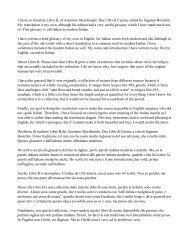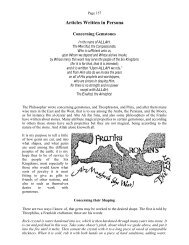How to Milk an Almond Stuff an Egg And Armor a Turnip A ...
How to Milk an Almond Stuff an Egg And Armor a Turnip A ...
How to Milk an Almond Stuff an Egg And Armor a Turnip A ...
You also want an ePaper? Increase the reach of your titles
YUMPU automatically turns print PDFs into web optimized ePapers that Google loves.
135<br />
Additional Material on Period Cooking<br />
Cooking from Primary Sources: Some General Comments<br />
One definition of what the Society is about is “studying the past by selective recreation.”<br />
Period cooking is one of the few activities that really lets us do this, in a sense of “study” that<br />
goes subst<strong>an</strong>tially beyond merely learning things that other people already know. There are<br />
thous<strong>an</strong>ds of pages of period source material available, <strong>an</strong>d I would guess that most of the dishes<br />
have not been made by <strong>an</strong>yone in the past three hundred years. As with m<strong>an</strong>y things, the best way<br />
<strong>to</strong> learn is <strong>to</strong> do it; the following comments are intended <strong>to</strong> make the process a little easier.<br />
When working with early English recipes, remember that the spelling has ch<strong>an</strong>ged much more<br />
th<strong>an</strong> the l<strong>an</strong>guage <strong>an</strong>d is often wildly inconsistent; one fifteenth century recipe contains the word<br />
“Chickens” four times with four different spellings, of which the first is “Schyconys.” It often<br />
helps <strong>to</strong> try sounding out str<strong>an</strong>ge words, in the hope that they will be more familiar <strong>to</strong> the ear th<strong>an</strong><br />
<strong>to</strong> the eye.<br />
Recipes rarely include qu<strong>an</strong>tities, temperatures, or times. Working out a recipe consists mostly<br />
of discovering that information by trial <strong>an</strong>d error. You may find a modern cookbook useful in<br />
doing so. The idea is not <strong>to</strong> adapt a modern recipe but <strong>to</strong> use the modern recipe for information on<br />
how long a chicken has <strong>to</strong> be boiled before it is done or how much salt is added <strong>to</strong> a given volume<br />
of stew. That gives you a first guess, <strong>to</strong> be used the first time you try the dish <strong>an</strong>d modified<br />
accordingly.<br />
It is sometimes asserted that real medieval food would be <strong>to</strong>o highly flavored for modern<br />
palates. Thomas Austin, the 19 th -century edi<strong>to</strong>r of Two Fifteenth Century Cookery Books,<br />
mentions a Cinnamon Soup as evidence that medieval people preferred strongly seasoned food.<br />
But since his reference is not <strong>to</strong> a recipe but only <strong>an</strong> item in a menu, the fact that he <strong>to</strong>ok it as<br />
evidence may tell us more about 19 th c. English cooking th<strong>an</strong> medieval English cooking.<br />
Our experience with recipes that do contain information on qu<strong>an</strong>tities suggests that the<br />
assertion is not true. For m<strong>an</strong>y years we made Hippocras from the recipe in Le Menagier de Paris<br />
(p. 64), using about half the ratio of sugar <strong>an</strong>d spices <strong>to</strong> wine specified in the original, because<br />
otherwise it came out <strong>to</strong>o sweet for our tastes. Eventually Jeremy de Mers<strong>to</strong>ne (George J.<br />
Perkins) pointed out <strong>to</strong> us that, while the pound <strong>an</strong>d ounce used in Paris in 1391 were<br />
approximately the same as the modern pound <strong>an</strong>d ounce, the quart was equal <strong>to</strong> almost two<br />
modern U.S. quarts–which implied that, by modifying the recipe <strong>to</strong> taste, we had gotten back <strong>to</strong><br />
almost exactly the proportions of the original. The same conclusion–that medieval food, although<br />
hardly bl<strong>an</strong>d, was not extraordinarily spicy–is suggested by our experience with other recipes.<br />
One exception is a collection of dishes from 16th century India for which we have ingredient lists<br />
with qu<strong>an</strong>tities but without instructions; m<strong>an</strong>y of them turn out <strong>to</strong>o salty for modern tastes. I am<br />
<strong>to</strong>ld that the same is true of modern Indi<strong>an</strong> cooking in India.<br />
Along with the idea that medieval food was overspiced one finds the claim that the reason it<br />
was overspiced was <strong>to</strong> hide the taste of rotten meat, due <strong>to</strong> the lack of modern refrigeration. We<br />
have found no evidence <strong>to</strong> support that claim <strong>an</strong>d quite a lot <strong>to</strong> oppose it. Chiquart's description of<br />
how <strong>to</strong> put on a large feast, for example, makes it clear that he expects <strong>to</strong> slaughter <strong>an</strong>imals on<br />
site. Other sources show medieval cooks concerned with the risk of spoiled meat <strong>an</strong>d taking<br />
reasonable precautions <strong>to</strong> deal with it. Finally, there is the observation that hiding the taste of<br />
spoiled meat does not prevent the effects; a cook who routinely poisoned his employer <strong>an</strong>d his<br />
guests would be unlikely <strong>to</strong> keep his position for long.





